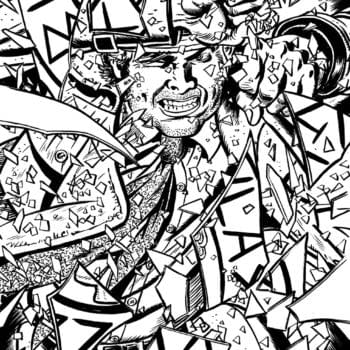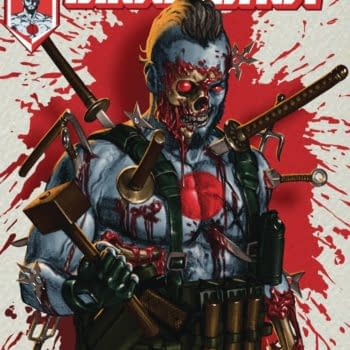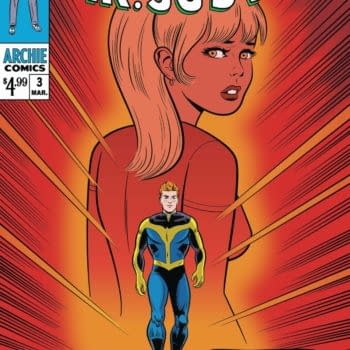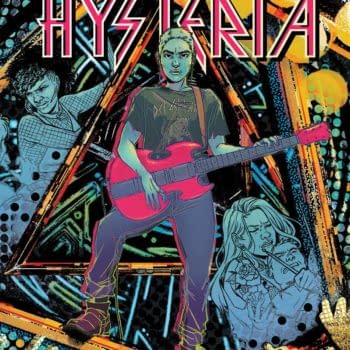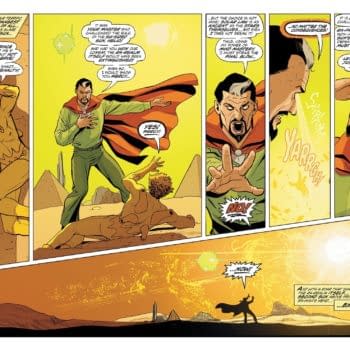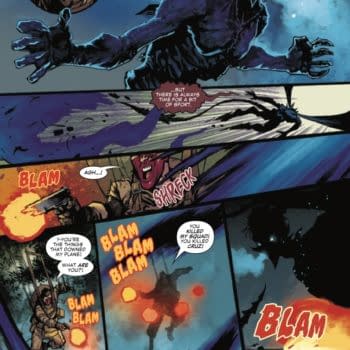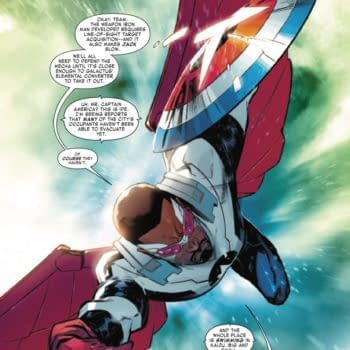Posted in: Comics | Tagged:
Dog Named Indie #3: Irene Survivors by Louis Falcetti
If you're interested in making comics, read on for a unique and entertaining look at the minds, process and work of some very talented young artists on a new anthology.
You know you can go through life, totally oblivious to something, but once it's pointed out you can't miss it? In Fight Club Tyler Durden points out the film's "cigarette burns" (you know, back when cinema's used film. *single tear*) and from that point on, your eye catches every one. That's how my life has been with The Center for Cartoon Studies. I knew literally nothing about the institution, then in San Diego I picked up some books from some of their students & alums. Now every time I'm out comic hunting the best stuff I'm picking out is somehow directly connected to CCS. Which is what brings me to Irene 1.
Edited and put together by Dakota McFadzean, Andy Warner, and dw featuring work from them as well as Nate Wootters, Jon Fine, and Rachel Dukes. Irene 1 is an anthology of short comics that come at the reader from all directions, really showing the huge swath of creative expression that comics are capable of delivering by joining together so many different voices and styles. Especially when those voices and styles are from artists who are extremely talented and skilled in their craft.
Jon Fine's "Endswell" takes a look at a former boxer turned tattoo artist turned trainer, crafting a vignette reminiscent of The Wrestler in it's emotional scope and authenticity. McFadzean's "Skeletons" is a haunting yet honest story about facing some of the earliest hard truths that children have to go experience and the way the imagination fleshes out (pun intended) inner anxieties. "Come Into My Heart" by Andy Warner follows two teens who cut school to drop acid by the ocean, it's as beautiful, sad, loving and honest as you're probably imagining. dw writes and Rachel Dukes draws "Solly Sitizen, Daymaker in 'Workin' for the Clampdown" which is one of the more surreal strips I've come across in awhile but at the same time isn't a random smattering of eye gouging weirdness (poor choice of words that) it's a very purposeful bit of eye gouging weirdness. Seriously though, it's impossible to talk about, it's like if 3 Days of the Condor had sex with Adventure Time, directed by Bunuel. Nate Wootter's "Blueberry" closes the book with a story about a boy, his dad and the monster in the closet. It's horrifying and perfectly illustrated and will leave you with a throbbing brain and dry mouth.
I got a chance to talk to the editors and Rachel about their pieces and the experience of putting the book together. Copies are available from Dakota's store as well as the Hic & Hoc table at the Brooklyn Comics and Graphics Festival on November 10th.
First up, a group chat with the editors about the process of putting together Irene 1:
Is Irene the first anthology you've edited? How did Irene come together? Do you think "I know great artists, lets make an anthology" or is it more "Lets make an anthology, who do we know?"
dw: It was a bit of both. Irene 1 is the first anthology we've edited as a group. Some of us have been in other anthologies or have co-edited other anthologies before, I think. Is that right, guys? I haven't edited or co-edited any others, but thanks to Andy, I was in Samandal 13 this past summer. Andy, you guest-edited Samandal 11, right?
Andy: Yeah. I guest-edited Samandal 11, which came out summer 2011. I also did an anthology in college called The American Walrus, but it wasn't very good.
Dakota: I was involved with a collective back in Saskatchewan, but not really in the editorial sense. It was a bit like a support group for cartoonists to get together and have a reason to draw pages. Cartoonists need that sometimes. I also curated an exhibition of local comics there.
dw: The genesis of Irene 1 was this: When we were all in grad school together, Andy was asked to give a lecture about comics in the Arab world. Andy is very knowledgeable on that subject and has spent time living and creating art in Lebanon and other parts of the Arab world. He has been in, I think, every issue of Samandal to date and is friends with many of the artists and editors in Samandal. The last thing Andy said during his lecture was, "The Samandal crew and other comics publishers in the Arab world are able, against great odds, to put out really good comics together because they work in collectives. So never underestimate the power of the collective." I decided to take him up on this and told him that we should start a collective together as a way to encourage each other to keep making comics after we got out of grad school. He accepted the challenge. Somehow it just seemed natural to ask Dakota to join, probably because we both look up to him so much as an artist and like him so much as a guy.
Andy: I was also living with him at the time. He obviously had to be in the secret club.
Dakota: D'aww, you guys. Of course, it would have been weird if you had kept it a secret from me. I would have been like Homer Simpson in the Stonecutters episode.
But yeah, we used to have a lot of conversations about work and the ritual of working, which I think played into our mutual desire to work together. Dave and I sat next to one another in a shared studio space, so we always felt accountable to one another. We would have these long conversations about work, discipline, ritual and how it almost becomes a meditative act. Then I'd go home for dinner and Andy would be at his desk, having worked since 6am, and we'd have the same kind of conversations. It was a really inspiring, affirming time. For my part, it cemented the way I approach working.
A lot of our early discussions about working together after graduation were founded on the idea of still being accountable to one another. To keep that dynamic going.
dw: Then we didn't know what to do with the collective, but Andy pushed for the idea of just putting out an anthology, so we started to plan one. It gradually, over many months, it evolved into the minicomic format in which it ended up. We might do other projects together in the future, but right now, Irene the collective is entirely focused on Irene the anthology.
We should mention that Irene 1 was made possible by a grant from The Inky Solomon Center, with the gracious help of Michelle Ollie and Valerie Fleisher. Also, we used Good Pals Printing for the physical production and screen-printed cover, and they kicked ass and made the book look really good for us.
Did you all edit each other's work? How do the editorial duties get broken up?
dw: We pitched our stories to each other, but there was little editing of each other's work. There is an implicit trust and mutual artistic admiration amongst the three of us, which is why we decided to form the Irene collective in the first place. I think each of us wanted to keep abreast of what the other two were up to, but we were all content to let the other guys do their things. We'll see if this trend persists in future issues or if there is more cross-editing or collaboration.
General editorial duties were not explicitly broken up or assigned. To varying degrees, we all provided feedback and support for the other three artists in Irene 1. Jon wanted a fair amount of feedback while he was in the early conceptual stages of his story and we were happy to provide it. As the story evolved and changed, he occasionally requested editorial feedback, but we liked what he was doing, so we mostly stood back and let him do it. We asked Nate for a chance to review his script before he went to pencils, and he was happy to show it to us. We had some editorial feedback, but the script remained more or less unchanged from that point on. I masterminded every detail of my story, including character design and thumbnails, before handing it off to Rachel to illustrate. Once she took over, she and I were in constant dialogue about script and layout changes that needed to be made in order for the story to work. She consulted with me about all of the changes that she wanted to make, but she knew exactly what she was doing and did it brilliantly. I can't remember ever disagreeing with any of her suggested changes, so she actually sort of ended up editing me, rather than the other way around.
Where does the title come from?
dw: From this asshole hurricane that tried to drown White River Junction in the summer of 2011. There was serious flooding throughout the town and the comics library at our grad school was compromised (the building itself, that is; every single one of the actual books was saved by James Sturm, Michelle Ollie and Caitlin McGurk). We decided to name our collective and the anthology after Hurricane Irene as a middle finger to the hurricane. Fuck you, Hurricane Irene. Next time, you best bring kryptonite.
Andy: Or a gun.
Dakota: Or just continue being a hurricane because hurricanes are pretty scary as is.
What has the experience of putting together Irene been like for you? Will the 3 of you be doing more anthologies together?
dw: It has been gratifying and stressful and fun. We are really proud of all the stories in the book and how the project as a whole turned out. But we also know that we are capable of better, and mean to prove it with the next issue. We are already in the planning stages for Irene 2. We're going to do two of them a year and have no plans to stop ever.
Andy: Yeah, since we're separated by a continent now (Dakota's in Montreal, Dave and I are in the Bay Area), the plan is to have them to debut at the spring and fall conventions on the east and west coasts. TCAF, MoCCA, Stumptown, APE, SPX, etc.
Dakota: It was a learning process for sure. Which is weird because we've all put together plenty of books before, but we learned very quickly that there are always initial oversights. I think the process will get smoother and more focused as we go along. We all had really busy, tumultuous summers while we were putting Irene together, and the book really added to that. I'm grateful for it though because that's why we started this thing. It's a lot harder to make up excuses for yourself when you know you've got two pals who are working on borrowed time too.
Does Irene have a conscious theme? I ask because after my first read I didn't think so, but the more I went through it, the more I noticed that they did all share similar ideas and themes about loss, acceptance, disappointment and change.
dw: It does not have a conscious theme. We all wanted to do stories for it and we asked three of our favorite artists, people we trusted to turn in top-notch shit, to do stuff for it, and they all did us a huge favor by agreeing to contribute. It wouldn't have worked if we hadn't gotten artists of their caliber to contribute for our debut issue. So no, there was no conscious theme going in. However, partly by accident and partly by the juxtaposition of the stories in the particular order in which they appear, I happen to feel that some kind of overarching super-narrative did emerge. All of the stories, all five of them, are about two characters trying to accomplish something or figure out a strange situation in which they find themselves. You could almost imagine that they are different incarnations of the same two characters, or something? I like to imagine that the main male character from Andy's story might be a grown-up version of the main character from Dakota's story. But that's just one example, and I'm sure there are other connections that are open to interpretation or extrapolation. I think that right now we are generally opposed to themed anthologies (not in general, but just for ourselves) and would rather just ask artists we admire to contribute and trust them to do what they do. But in the future, we may or may not do themed issues of Irene.
Andy: Yeah, themes could be something interesting to try, but we're concentrating on just putting out good comics right now. Weird patterns crop up in the ordering of pieces in an anthology, and that can create really interesting and unexpected associations.
Dakota: The three of us are generally attracted to similar stories, so I think we unconsciously gravitate towards the same kind of stuff. That said, we're tapped into different aesthetics and approaches too, so ideally we balance each other out. I'd definitely like to try a theme issue at some point, but themes are hard. If it's not handled right, the whole book can become monotonous and limited in scope. I think we'll probably try to get a few more issues of Irene out before we impose another challenge on ourselves.
Talking with Dakota about "Skeletons"
Where does Skeletons come from?
Skeletons is based on something one of my friends told me when we were kids. He said that his cousin's house was filled with skeletons that would secretly look around corners and watch you, but if you tried to turn around and look at them, they disappeared before you could see them. This really crept me out, and I still think about it when I'm alone and I have my back to a doorway. Even if it was just kids being fascinated by creepy stuff, ideas have a way of following you.
You're Canadian, but the comic has a decidedly American kind of desperation running through it. Would you say that's accurate or am I just unaware of Canadian desperation?
There's definitely Canadian desperation too. We don't have nearly the population that the U.S. has so it's maybe not as concentrated, but it's certainly not hard to find desperation. I grew up in a poor neighbourhood in Regina, which is a smallish city in the province of Saskatchewan (think of landscapes like the state of Kansas and you've got it). Actually Maclean's magazine infamously called it 'The worst neighbourhood in Canada' a few years ago. That really pissed the city off! Everyone was all like 'Never mind our poor, marginalized people over here. What about YOURS over THERE?!' It became a bit of a circus.
My family was working class, but usually comfortable. That said, when you're a kid, you don't think much of classmates coming to school without winter coats in -40 weather. You think, "Man, that kid should really wear a coat," and not, "Oh wow, that kid doesn't have a coat for a whole host of reasons I'm not ready to begin understanding."
Does everyone have skeletons chasing them? Is it better to keep running or should we turn around and attempt to face them?
Yeah, I think we all have skeletons behind us. They're probably there whether you turn and face them or not. And even if you do turn and face them, they'll just act like they're not there anyway. Probably the best thing you can do is tell someone, so that the skeletons will follow them too.
I just looked up Weyburn and discovered the comic takes place in Canada, I had no idea our cultures were so closely related, at least in terms of poverty, the 1980s (early 90s?) and adolescent heartbreak. Do you find yourself creating with one culture more in mind than the other or do you try to make art that isn't culturally bound?
I think it's hard to write from outside the culture you were born into. I mean, you can do research and visit places, and try to put yourself into other people's shoes, but at the end of the day you're still you can really only think your own thoughts. Your personal experience will always be the point of comparison when you encounter something outside of that. I tend to write about things that my brain keeps returning to over and over, so often the settings end up being the prairies in the 80s and 90s. That said, art is a great way to experience and understand other cultures and perspectives. I had an art instructor who liked to remind us that although no idea is original, no one has explored a given idea as you, in this current year, in this place.
Since 2000 more and more Canadian artists and musicians have been gaining recognition and acclaim stateside, what is going on in Canada that it is turning out all of these talented folks?
Whoa now. Let's not forget about Neil Young and Rush!
I'm not sure what's going on in Canada, it could simply be that we're all more connected through the magic of the Internet now, and so we can hold hands across the world and join one another in song.
In the larger picture, it could be a couple of other things. For one thing, we do have fewer people. So maybe when someone makes something, it's easier to get the attention of audiences and gatekeepers. When I was 20, I had a weekly comic strip in my local newspaper. An editor gave me a chance in the name of local content, and even though the strip was pretty bad at first, it ran for six years and gave me a chance to develop my chops. You learn a lot when there's a regular deadline. When the strip ended, it led to other opportunities, which in turn led to others. I was really lucky to have this and I probably couldn't have gotten away with it in a larger, more populated place.
Another reason is arts funding. Canada is going through a pretty conservative period right now, but we still have pretty-good-but-could-be-better funding for the arts at the federal and provincial levels. The thing is, good art isn't always commercially viable art. Take comics for instance. Only a small portion North American people currently read comics, but it doesn't mean comics aren't worthwhile. It makes sense to me that a government, through the use of arms-length agencies, would invest in the cultural future of their people. And I'm glad they do, because Drawn & Quarterly puts out some of my favourite books and they receive funding.
Anyway, if an artist can get a small grant to work on a project for a little while instead of worrying about eating, that artist tends to log some serious hours of work and learn to make better, more interesting art.
Looking over your Dailies I've noticed a number of them having to do with children. What do you like about childhood/adolescence that makes it so fertile an idea space for turning out work?
For me, making comics is a very meditative thing. Cartoonists tend to spend a lot of time alone with their own thoughts and memories. Inevitably I end up sifting through the last two or three decades, thinking about childhood, things I thought, ways I felt, and so on. Also, drawing is one of my oldest friends, so the act of drawing can connect me pretty directly with my childhood.
On top of that, childhood is such an emotionally rich time. Experiences are new and exciting and terrifying. You don't know anything, but you think you do (just like adulthood). You're also still figuring out what's real and what isn't so you can't just brush away a fear and worry about paying bills instead.
Finally, kids are assholes. And they can get away with being assholes because they 'don't know better.' But they do know better! Trust me, I used to be a kid.
What are you working on now and where can people go to find out more about you and your work?
Right now, I'm working on a few different things. I'm doing some freelance colouring and illustration here and there. Plus a strip for a couple of alt-weeklies. I'm planning on putting out a second issue of Last Mountain which is a mini-comic collection of my short stories. Finally, I've started thumbnailing a longer story so that I can finally be a real graphic novelist just like in the movies!
People can see a more of my work at http://dakotamcfadzean.com. The site has some short stories, a shop, and over 1000 dailies.
Talking with Andy about "Come Into My Heart"
Most of the time I'm reading and reviewing more sci-fi, super powers, dystopian future nightmare comics, so I'm never sure about whether or not "Is this autobiographical?" is the "slice of life" comics equivalent question of "Where do you get your ideas?" which I know that creators hate getting. Does this happen to you when people ask you about your work? Is it annoying? Is it inevitable when creating stories that reflect human lives that the artist's own personal narrative will bleed through on some level?
No, I think this is a legitimate question. Everyone's work process is so different. I've done work that's straight autobio (the Beirut comic you mentioned earlier, for example), fake autobio ("Squirrel" in Two Stories, which was a dream I had), and straight fiction. Come Into My Heart is fiction, but it, like The Creeping Things, is layered on top of real experiences I've had. I never try to hide or deny this. In fact I think it's inevitable for me. A real-life event that is powerful and profound can be used to create a fictional event that is also powerful and profound. I think the key is not being afraid to change these experiences in the service of the story, and to be careful to not make everyone seem like reflections of the author.
Where does the title, Come Into My Heart, come from?
It was actually a bit of a song lyric that got stuck in my head last spring. I kept repeating it over and over again and really liked it. As I was writing what would become Come Into My Heart (it started out as a much longer story), I came to really like the idea of expressing a sentiment in the title that both characters in the story want to express to each other, but, for different reasons, are unable to.
Have you told a long form narrative, outside of just one work? Do you ever have the desire to revisit characters from a strip or graphic novel?
I haven't yet, but I'd like to. I'm never quite ready to write characters off once the story's done with them. We'll see…
What can you tell me about Frown Town?
Frown Town is a puppet show that I created with my friend, Steven Foundling. Steve's a fantastic artist, we've known each other since college, and we've collaborated on a number of overly ambitious projects (including my first comics anthology, actually!). I was living in San Francisco, he moved out here, and we decided to do a puppet show together. It got put on hold for two years while I was in grad school, but now it's back on, we've got one episode up, and we're filming the second right now. It's a downbeat black comedy show (you can see the episodes and the extensive production blog at frowntown.net) about street urchins featuring beautiful puppets and abandoned houses.
What are you working on right now? Where can people go to find out more about you and your work?
A children's ebook I did the art for about neurobiology called Ned the Neuron just came out, actually! You can see it at kizoomlabs.com. I've got a story in the first issue of Symbolia (symboliamag.com) coming out soon, too. Right now, I'm working a contract job doing the penciling, inking and coloring for a comic called A Fantastic Story, which is a kind of fantasy story. I've gotten the go-ahead to put some of the concept art for that up on my blog, so I'll be doing that in the coming days. As the project nears completion next month, I'll be posting some finished art, too. After that, I'm hoping to do some more non-fiction reportage comics and start working on my story for Irene 2, which we'll have out for the spring indie comics conventions. You can follow my (sporadic) updates at andysaurus.blogspot.com.
Talking with dw about "Solly Sitizen…"
Are there other Solly Sitizen/Daymaker comics out there? The world seems so realized that it didn't feel like your first trip into that land.
Solly made his initial appearance in a story I did as an assignment in grad school. I fleshed his world out pretty thoroughly at that point, but it has evolved somewhat between that first story and his appearance in Irene 1. I don't fully know or understand this world, but I know that there is a lot of it out there. I'm only slightly more informed about it than the reader. And as jaded as Solly seems, I don't think he knows much more about it than I do. He knows his way around, but as you can tell from the story, he has a lot of shit to figure out about his life and career.
I have some ideas knocking around for other stories set in the same universe, and they may see the light one day.
How would you describe your artistic style? Solly was illustrated by Rachel Dukes, but you also draw your own work as well. Do you prefer writing or drawing? Does one influence the other for you? Do you change the way you write when someone else is illustrating your words?
I don't prefer writing to drawing or drawing to writing. But they exist as entirely separate practices for me. I like writing; I enjoy making up characters and situations and story structures. I find it fun and it comes fairly easily to me. But when I am drawing, I can only doodle or collage, not tell stories. For the most part, and with occasional exceptions, I just find the practice of making narrative sequential comics to be too rigorous and too boring. I can't draw the same character over and over again, both because I can't concentrate long enough and because I'm not draftsman enough to stay on-model. Rachel can not only do both of those things, but she can draw my characters and their world better than I can draw them, so I trusted her to take my ideas and make them work. She did me a big favor by taking this story seriously and giving it her all. I am very proud of it, partly because I feel like I did a good job of creating the characters and their world and of structuring the story, but mostly because Rachel brought it to life so vividly. It wouldn't have worked at all without her.
When someone else is illustrating my words, especially someone as capable as Rachel, I feel liberated. I can think up the most insane shit and can trust her to realize it. But it only works with someone as good as her. Knowing that she was on board for the story gave me the freedom to write what I wanted to write and to go as crazy as I could with it. I thought up things that I would never have had the guts to try to draw myself, and she pulled it off.
Did you know the story you wanted to put in Irene or did you need to come up with something and found this in your head?
The idea of doing the anthology came before I decided to use this particular story for the anthology. But this story had been kicking around in various forms for a while before we decided to do the anthology. Once we did, I dusted it off and worked it to a spit-shine and then worked closely with Rachel to get it ready for her.
Has anyone made your day recently? Were they wearing shades?
Several people have recently made my day. None of them were wearing shades, but one of them was wearing regular prescription spectacles.
Why is it ok if the kids do it but not death dude?
It's complicated.
Perceptions of reality seem to be a theme in Solly, do you find yourself defining your reality through your work or do you find that you escape reality through it?
More the former, I think, both when I'm drawing abstract psychedoolia and when I'm writing narrative comics.
But actually, I'm not sure I understand what you mean about perceptions of reality as a theme in the story. Do you mean that all of the characters perceive reality different? I think I view their differences more as differences of principle than of perception; do you see what I mean? Like, Solly and the Chief aren't in disagreement about the mission or about who's responsible for it. They just disagree about whether the ends justify the means – about how far you can go to accomplish your goals and still remain true to your cause. I think (once the dust from Solly's lies and misplaced promises has settled) that they are in crystal-clear agreement about what has happened, but that they disagree vehemently about whether or not the fact that it has happened is morally acceptable. But that's just one example; I'm probably missing some important stuff that you picked up on.
How do you describe Solly, so that I can have an easier time of telling people what it's about. I find myself just saying "You need to just read it."
Two characters who stand for opposing things put their differences aside to neutralize a common threat and find themselves compromising their principles to do so. They are then forced to stand by this decision and accept the consequences. Neither of them is sure if this was the right thing to do, but only one of them seems to give a shit whether it was. Also, they are very cute.
Is there anything your working on right now that you'd like to talk about? Where can people go to find out more about your and your work?
I draw a picture every day and post it online. The drawings are posted to http://kidclampdown.tumblr.comand to http://www.flickr.com/photos/davewpictures/.
Besides being a character in the Solly Sitizen Irene story, Kid Clampdown is also the name of my self-published minicomic. It comes out roughly whenever the hell I feel like it. Issue 8 debuted at APE 2012 and will be on sale at the Hic & Hoc table at the 2012 Brooklyn Comics and Graphics Festival on November 10th, along with earlier issues of Kid Clampdown and a bunch of prints and copies of Irene 1.
Also debuting at BCGF is Abzernad, a brand new minicomic that I made for Hic & Hoc. I was invited to do this by Hic & Hoc and I am very honored to have been asked. The content in Abzernad stands entirely apart from my Kid Clampdown books and from Irene. It's a whole different kind of thing. It's somewhere between a logical, ordered sequence of drawings and my usual crazy psychedoolic nonsense. I worked hard on it and both Hic & Hoc and I are really proud of the result. It's eventually going to be on sale through Hic & Hoc's online store, but all of your readers who are going to be at BCGF should come by the Hic & Hoc table, because the first ten people to buy Abzernad at BCGF are going to get a really cool free prize thrown in.
And finally, talking with Rachel Dukes about drawing dw's "Solly…"
I've only been familiar with your work through comics you've both illustrated and written. Do you illustrate others work often? How did you come to be involved in Irene?
Though I've been drawing comics for ten years, I didn't have the opportunity to illustrate someone else's work until two years ago. Cartoonist Ryan Estradacontacted me about illustrating a story he had written for Zuda's comics competition and we worked on that for a number of weeks before finding out that Zuda was shutting down. After that, Ryan added me into the fold of illustrators that take commissioned comic work through Cartoon Commune.
The commissions I receive mostly single-page illustrations. Because of that, illustrating comics written by others isn't something I do very often. Like most, I'm often isolated while making comics – doing so as a way to connect to the world and the people around me. So to have the opportunity to collaborate with someone (especially someone who is also passionate about comics) during the creative process makes the experience of the comic – the concept, creation, and introduction to the outside world – that much more fulfilling.
Like everyone involved in Irene #1, I'm a student at The Center for Cartoon Studies. (The Irene gentlemen have all graduated but I'm still enrolled, currently working my way through my thesis.) Last year, I was taken under the wing of DW, Andy, and Dakota. They invited me to submit something for consideration of inclusion; which I did. It turned out that DW was looking for an illustrator for his story, 'Solly Sitizen, Daymaker in "Workin' for the Clampdown"', and asked if I would be interested in collaborating on that in lieu of publishing my submitted work. I liked the story and I accepted.
Are there any challenges to illustrating someone else's script that you don't find when working on your own?
The most difficult challenges I've faced when illustrating work written by others have always been about trying to fit too much dialog or narration onto a page. With my own work, I can always take liberties: cutting lines or breaking pages in two. But that isn't always an option when working with others.
Fortunately, working on Irene, DW had done the thumbnails for me so I knew exactly what he wanted on each page. And if I had any doubts, he was easily accessible for me to question and open to changes I saw as necessary. It was one of the most seamless collaboration I've had the pleasure of working on.
What are you working on and where can people go to find out more about you and your work?
Because I'm still enrolled at CCS, I'm currently working on several short stories to put towards my thesis at the end of the year. I'm currently in the final stage of revisions for a 72-page comic about sexual coercion, romantic missteps, and regret. That will be posted on my blog, Mixtape Comics, upon its completion in a few weeks. (I'll be offering a print copy of that for sale in my webstore, Poseur Ink, as well.) I'm also working on a handful of illustrations for assorted, unannounced projects that will be available next spring. In the meantime, Mixtape Comics is the best place to find me.
Thanks to all the Irene artists and editors for talking with me and for putting out such a great book. And thanks to CCS for turning out such great students.
Follow Louie on Twitter












